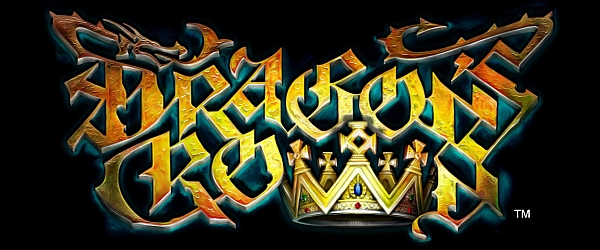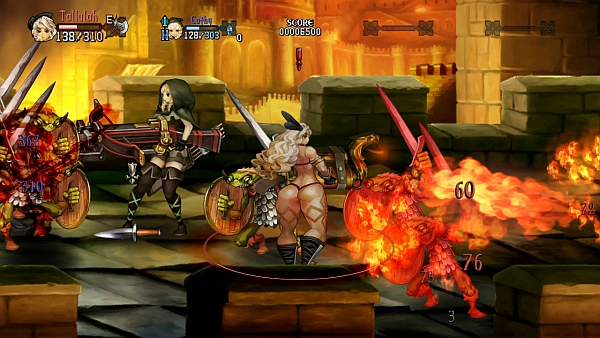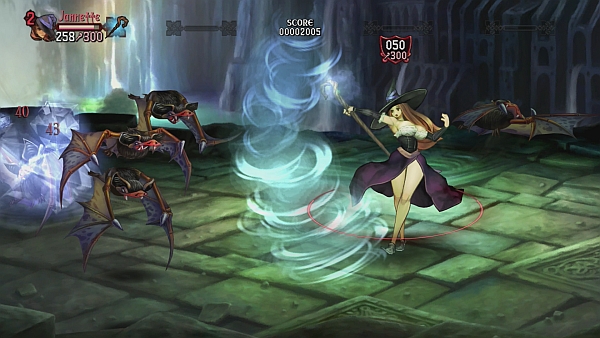
Dragon’s Crown is a beautiful new side-scrolling beat ‘em up from developer Vanillaware and publisher Atlus. It’s garnered a lot of bad publicity due to some of the art design choices, specifically the outrageous, over-the-top character models for some of the females. While the art style does take some stereotypes to the extreme, there’s no arguing that what the developers have done here is created something gorgeous and immersive and completely original. On top of this, Vanillaware has delivered a copious amount of entertainment in a tried-and-true genre, and they’ve done it on not just the PlayStation 3 but on the Vita as well, giving you the chance to continue the experience on the go. Does the gameplay make up for what many consider to be a questionable art style? Absolutely.
Platforms: PS3, Vita (Both Versions Played)
Publisher: Atlus
Developer: Vanillaware
Genre: Sexy Beat ‘Em Up
Release Date: August 6, 2013
ESRB Rating: Teen
Dragon’s Crown begins with a character selection screen, in which you can choose from the Amazon, Dwarf, Elf, Fighter, Sorceress, and Wizard. Each one has a short, general description of what it does, mostly what level of player it’s intended for (the Dwarf is for “normal” players, while the Sorceress is for those with experience, as she is more of a support character). From there, you get a tutorial that explains what all of your basic moves are. This is great for player one, but players two through four don’t get this tutorial section, so they’re on their own figuring out how to play their character. Granted, no one is overly complicated, outside of the magic users.
From there, you begin the game in town, and are lead through the various places therein – the magic shop, the adventurer’s guild, etc. It’s pretty basic fare for a fantasy village – in fact, everything in the game is pretty basic fare, which, if you play Dungeons & Dragons in any of its many formats, makes you feel right at home. As you work your way through the Quests given to you, more places in the town unlock, and more options open up for you. Likewise, as each Quest opens, you go through the Gate to new areas, and more mission areas unlock.
Each Quest gives you experience points, and as you level up, you also gain Skill points, which can be attributed to a wide variety of skills either from your class or from a Common category. These Skills can be leveled up as you progress, making them more powerful. The arcana-based classes can unlock spells this way, which can be placed into your inventory and used a certain number of times per dungeon. This is also how various items work – you start with a healing potion in your bag that has three uses per dungeon, and you can purchase better ones at the shop. Items have a cooldown once you use them, and the cooldown can be improved with Skills.
While in the village, you can go into the Start menu and change up your equipment, look at your skills, and check on any sidequests you may have picked up at the Adventurer’s Guild. But once you’re in the thick of things in the missions, you can no longer make these changes – that is, until later in the game, when you move into a more intense version of gameplay and can create custom loadouts (in the form of having additional bags) and change them at specific moments as you progress through adventures.
Sound confusing? It’s really not. The game is simple and, at first, might seem too easy. But once the storyline opens up, it feels like a caterpillar emerging from its cocoon as a butterfly – suddenly, all the grinding you’ve been doing turns into something completely different, and far more challenging. Your gear decisions change from “what has the best numbers” to “what is the best thing to use in any given situation,” and you set your loadouts to match those decisions. And the repetition and concern over the game being too easy goes right out the window.

Treasure comes in all shapes and sizes, spewing from chests or gained as spoils at the end of each Quest. You have a Rogue with you named Rannie, who you can direct to unlock chests and doors for you. There’s also a jerk who looks like a mean version of Rannie who spends his time trying to steal your treasure, so beat him up whenever you see him on the screen. Using the left stick moves your character around, and the right stick pulls up a cursor that lets you point and click on whatever you want Rannie to unlock for you. This cursor can also find hidden treasure on the screen in the form of small, bright dots that you can click on. These dots shoot out everything from golden skulls to pearl necklaces, so be on the lookout for the extra points. The treasure itself is ranked, starting with S, then moving from A down to E. In the post-mission screen, you can choose to appraise your spoils or sell them without appraisal, which nets you more gold for them.
There are a few complaints I have about the game, starting with how much is happening on the screen. If you’re playing a multiplayer game, sometimes you have all of your characters on the screen, plus Rannie, plus whatever summoned creatures your arcana characters might have following them, plus all of the enemies on the screen. Even with the color-coded circles around each character, the screen can get quite crowded and confusing. In those moments, melee characters can best make it through by button-mashing, and arcana characters just need to make sure they’re somewhere they can safely attack and regenerate their magic points.
Another major complain is that everyone other than the first player has extremely limited options. Rune magic is unlocked after a few hours, but the only player who gets access to the first rune is the first player, and they are also the only ones who can purchase runes. Additionally, each player must pick up sidequests separately, and if the other players don’t have the quest, they won’t get the experience for it and will have to do it again to get credit for it. They also can’t get access to additional bags once the custom loadout options are unlocked – extra bags and runes are simply not available for purchase in the store for them. This dilutes the experience of the other characters, which is a very strange decision for a game that focuses so heavily on the multiplayer experience.
Finally, the menus can be difficult to navigate at first. Ideally, in a game like this, in which you have gear that you can apply to your character, there should be slots to show where the items are going. The Dwarf can wear a mantle and use gloves, while the Sorceress can wear glasses and bangles. Once you put an item on from these categories, trying to put on another item in that category will unequip the first one. You can get the hang of it quickly, but it’s confusing at first because the only real indicator is that once you click on, say, gloves, you are automatically taken to gloves wherever they are on the list in your bag. But it’s easy to get confused before you get used to the pell-mell way things are arranged. Also, the fact that each player has to go into menus separately is frustratingly annoying, especially after spending hundreds of hours in the Borderlands series, where menus can be open separately on the screen, making it less invasive and far less boring for the other player.
All that being said, Dragon’s Crown is a fantastically fun game. The art style is unique and robust, from the player characters to the NPCs to the lush backgrounds. Many of the enemies are amazing as well, bringing villainous and monstrous stereotypes to life. Having the freedom to focus on specific Skills is fun as well, and while it’s not as in-depth as conventional RPGs can be, it breaks the beat ’em up mold by adding another dimension to what would otherwise be completely flat characters. The narrator is a lot of fun, changing voices for each NPC and really getting into the story. And unlike many other games, when you swap weapons and gear, not only does your character change, but the sounds your weapon makes change as well, making it feel more convincing and immersive.

And, of course, no review of Dragon’s Crown would be complete without some comment on the Amazon and Sorceress, whose gravity-defying assets have been the center of much controversy and scorn. I played as the Amazon first and the Sorceress second, and I got nothing but entertainment and enjoyment out of both characters, especially the over-the-top ridiculous way the Amazon jumps into the air, and the dainty way the Sorceress grabs her hat when she runs. If I were to get offended by them, I would have to also be offended by the stereotypes of the male player and non-player characters – the Fighter, whose muscles defy all convention; Roland, who is made of nothing but beef; and the more hideous characters like the Old Man and Lucaine. If anything, Dragon’s Crown’s artistic stereotypes are uniform across the map, and people will either be offended by it wholly or not at all. I fall in the latter category.
One of the best parts of the Dragon’s Crown experience is how it plays on the PlayStation Vita. Though there is no Cross-Buy option, there is cross-play, allowing you to sit in your living room and tear Goblins up on your couch, and then save your game, port it to your Vita, and continue the experience on your way to wherever it is you’re going. The game looks absolutely beautiful on the Vita’s screen, and nothing is lost in translation – from the crisp, clear graphics to the simple gameplay. If anything, I have been enjoying it even more on the Vita, where I’ve decided to take up the campaign as the Dwarf. There’s a great option that lets you pick up random bones found in the stages and bring them back to the village to be resurrected, where you can add them to your party as NPCs. So far, my Dwarf is kicking some serious butt with his drop-in pals.
Dragon’s Crown is a furiously fun game, packed with innovative ways to enjoy the side-scrolling beat-em-up genre while keeping things simple enough that they are familiar and easy to jump into. It has a unique art style and a changing storyline that keeps you on your toes, bringing in new gameplay elements and ramping up the challenge just as you begin to get lazy. Whether you’re picking it up for the PlayStation 3 or the Vita, you’re bound to have a good time with it, even with some of its shortfalls. With the PlayStation 4 looming on the horizon, this is a great way for the PS3 to go out with a bang… or, I guess, a lightning bolt.

Review Disclosure: A review copy of Dragon’s Crown was provided by Atlus for the purposes of this review.







